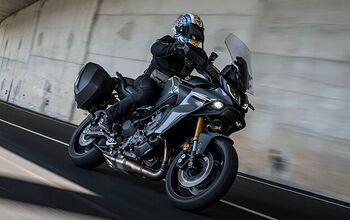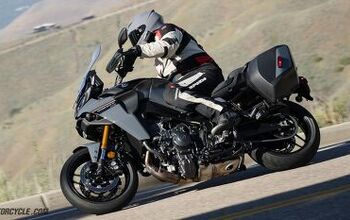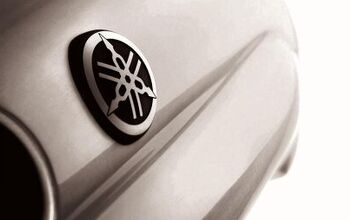Yamaha Motorcycle History: History of Yamaha

- 2010
- 1851Torakusu Yamaha is born. He will train as a watchmaker and make his first reed organ in his mid-thirties.
- 1890He incorporates Nippon Gakki Company Limited, for the purpose of making pianos and organs. The company’s origins as a musical instrument maker are still reflected in its logo, which depicts three interlocking tuning forks. It becomes the world’s largest musical instrument maker.
- 1916The founder passes away.
- 1955In the years after WWII, the company’s president Genichi Kawakami realizes that if Japan is to rebuild, the country needs affordable transportation (more than pianos!) The first Yamaha motorized product is the YA-1 Motorcycle. It’s a 125cc, 2-stroke, single-cylinder streetbike patterned after the DKW RT125 (as were both the BSA Bantam and the Harley-Davidson Hummer.) The YA-1, aka “Red Dragonfly,” is so successful that Yamaha incorporates a subsidiary, Yamaha Motor Corp.
- 1957The 250cc twin-cylinder YD-1 is an improved version of another German bike, the Adler.
- 1958The first Yamaha motorcycles are sold in the USA by Cooper Motors, an independent distributor. The models are the YD-1 (250cc, 2-stroke, twin-cylinder streetbike) and MF-1 (50cc, 2-stroke, single-cylinder step-through streetbike).
- 1959The YDS-1 mounts a tuned-up version of the YD-1 motor in a double-cradle frame (the earlier version was built on a pressed-steel spine). The YDS-1 establishes the pattern for the next 20 years of sporty Yamaha two-stroke Twins.
- 1960Yamaha International Corporation began selling motorcycles in the USA.
- 1964Phil Read gives Yamaha its first-ever World Championship, in the 250cc class.
- 1966The YDS-3 is the first Yamaha streetbike to really capture the American imagination.
- 1967The Yamaha TD1C 250cc production racer is released. Though the factory racers have been effective for years, this is the beginning of a brilliant run of proddie racers. More than any other manufacturer, it is Yamaha that forces out four-strokes engines from Grand Prix racing.
- 1968The DT-1 Enduro is introduced. It’s perhaps the world's first dual-purpose motorcycle.
- 1970Yamaha’s first 4-stroke motorcycle model, the XS-1 (650cc vertical Twin) is introduced.
- 1973Kenny Roberts wins the AMA Grand National Championship, racing a Shell Thuett-tuned 650 Twin on the dirt tracks and a 350cc two-stroke Twin (later TZ700 and 750 Fours) on road courses. He’ll repeat the win the next year, despite the 650 being outgunned by the Harley-Davidsons on the dirt tracks.
The fine RD350 middleweight sports bike is released. Its air-cooled 350cc parallel-Twin two-stroke motor is fitted with reed induction and produces an impressive 35 horsepower at the rear wheel.
- 1975Yamaha pioneers the very first single-shock production motocross bikes.
Giacomo Agostini gives Yamaha its first 500cc World Championship.
In a desperate effort to keep the #1 plate, Yamaha encourages Roberts to try a TZ750-powered flat tracker. He rides it to an epic win in the Indy Mile, but says, “They don’t pay me enough to ride that thing!”
- 1976The legendary XT500 is born. This thumping trailbike is the last nail in the coffin of the old British mystique. “The Japanese can even build a better 500 Single!” In its fourth year of production, an XT500 will win the first running of the Paris-Dakar.
- 1977Yamaha Motor Corporation, USA, was founded in order to better appeal to the American market and establish a separate identity (from music & electronics) for Yamaha motorized products.
- 1978The four-cylinder shaft-driven XS1100 is introduced.
Kenny Roberts becomes the first American to win the 500cc World Championship. He’ll win again in ’79 and ’80, proving that the first one was not a fluke.
The XS650 Special was introduced. This was the first production cruiser built by a Japanese manufacturer.
- 1979YICS (Yamaha Induction Control System), a fuel-saving engine system, was developed for 4-stroke engines.
- 1981Yamaha’s first air-cooled V-Twin cruiser, the Virago 750, is introduced.
- 1984The RZ350 (sold elsewhere as the RD350LC, for “liquid cooled”) finally reaches the U.S. market. It was popular elsewhere from 1980 until the early ’90s but is only sold in the U.S. for two years. It’s fitted with an exhaust “power valve” that dramatically improves mid-range performance.
The hairy-chested RZV500 is introduced. With its water-cooled V-4 two-stroke engine, it’s a Grand Prix replica for the street, but it’s heavy and no match for Suzuki’s RG500 Gamma.
The first production 5-valve-per-cylinder engine is introduced on the FZ750.
Eddie Lawson wins the 500cc World Championship. He’ll do it again (on Yamahas) in ’86 and ’88.
- 1985The V-Max 1200 muscle-bike hits the streets. Its 145 claimed horsepower sets a new motorcycle standard.
- 1987Yamaha introduces EXUP, a new exhaust system for 4-stroke engines that includes a power valve to control back-pressure for optimizing the width of an engine's powerband.
- 1989The FZR750R homologation special briefly challenges the GSX-R750 for sportbike supremacy.
- 1990Wayne Rainey wins the 500cc World Championship. He’ll do it again in ’91 and ’92, and is leading the 1993 championship when he suffers a paralyzing injury in mid-season.
- 1991Thomas Stevens becomes the only person ever to win the AMA Superbike Championship on a Yamaha.
The FJ1200A sets the sports-touring standard and includes ABS.
- 1993The striking GTS1000 features electronic fuel injection and hub-center steering designed by James Parker. Consumers failed to bite on the innovation and balked at the relatively high price.
- 1996Yamaha introduces its first Star model with the 1300cc V-4 Royal Star.
- 1998The YZ400F four-stroke motocross bike is introduced. This is the first mass produced 4-stroke motocrosser. Doug Henry won the AMA outdoor motocross championship with it while it was still a prototype in development. As soon as the public gets its hands on the production model, the two-stroke 250s are doomed.
The YZF-R1 sport bike is introduced to wild acclaim.
- 1999The YZF-R6 is introduced.
- 2002The R1 gets fuel injection, a first for a Yamaha sportbike.
- 2004Valentino Rossi wins the MotoGP World Championship. He’ll repeat the feat the next year.
- 2006The R6 gets YCC-T (Yamaha Chip-Controlled Throttle), a partial fly-by-wire system that is an industry first.
- 2007The R1 gets YCC-I (Yamaha Chip-Controlled Intake), a system that varies the length of the inlet tract depending on throttle position and engine speed. The bike also gets a slipper clutch. Nori Haga uses the race version to finish second in the World Superbike Championship, just two points behind James Toseland. Haga and teammate Troy Corser combine to win the Manufacturer’s Championship for Yamaha.
- 2009After an incredible run of more than 20 years, the Vmax is finally put out to pasture in favor of a new version powered by a monstrous 1700cc V-4 engine pumping out a claimed 200 horsepower.
Revamps the new YZF-R1, incorporating the cross-plane crankshaft to mimic the firing order of the M1 machine ridden by Valentino Rossi in MotoGP. Unlike traditional engines, each of the four crankpins in the cross-plane crankshaft are offset at 90-degrees from its adjacent crankpin.
Ben Spies, in his debut season in the world superbike championship, wins the title on the new YZF-R1 after a year-long battle with Noriyuki Haga.
- 2011Feel like riding around the world? Yamaha has just the machine for you with the Super Tenere adventure tourer, introduced as a 2012 model.
Information taken from official site ( http://www.yamaha-motor.com/corporate/historytimeline.aspx)

Motorcycle.com presents an unrivaled combination of bike reviews and news written by industry experts
More by Motorcycle.com Staff



























Comments
Join the conversation